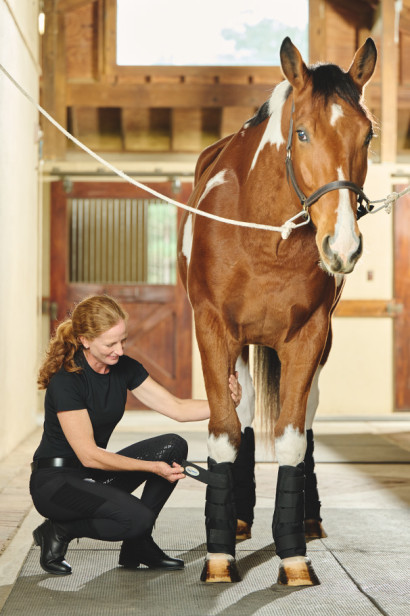Equine Therapy for Injury Recovery: Exactly How Steeds Help Heal Emotional Wounds
Equine Therapy for Injury Recovery: Exactly How Steeds Help Heal Emotional Wounds
Blog Article
Just How Laser Treatment in Equine Therapy Is Transforming Vet Look After Steeds
Laser therapy has actually emerged as a transformative strategy in equine vet treatment, supplying a non-invasive solution that expedites recovery and boosts overall health. The mobility and adaptability of laser therapy devices even more emphasize their growing necessity amongst veterinarians.
Comprehending Laser Treatment

The technology behind laser therapy is grounded in the principle of photochemistry, where photons are absorbed by chromophores within cells, resulting in boosted ATP manufacturing and inflection of responsive oxygen types (Equine Therapy). This, consequently, advertises cellular expansion, minimizes swelling, and speeds up healing. Vet practitioners use different kinds of lasers, including low-level lasers (LLLT) and high-power Class IV lasers, depending upon the particular restorative goals and the nature of the equine condition being treated
Various laser wavelengths and power setups are very carefully chosen to target different tissue depths and achieve wanted professional end results. Safety and security procedures are vital, as incorrect usage can lead to thermal damages or suboptimal restorative impacts. Thus, a comprehensive understanding of laser treatment's devices and applications is critical for its reliable application in equine veterinary technique.
Advantages for Equine Health
The myriad benefits of laser treatment for equine health include enhanced recovery, pain decrease, and enhanced mobility. This innovative treatment modality leverages details wavelengths of light to permeate cells, promoting cellular feature and promoting quick cells repair work. The non-invasive nature of laser therapy makes certain minimal stress and anxiety and pain for the equine, facilitating a smoother healing process.
Enhanced healing is one of the foremost advantages, as laser therapy accelerates mobile regeneration and collagen synthesis. Pain reduction is accomplished via the anti-inflammatory effects of laser therapy, which reduces swelling and lowers the manufacturing of pain-inducing chemicals.
Better movement is one more essential advantage, specifically for efficiency and working horses. By reducing inflammation and discomfort, and enhancing tissue repair, laser therapy helps in restoring joint feature and muscular tissue flexibility. The cumulative effect of these benefits is not only a quicker return to normal activity but also an overall enhancement in the horse's high quality of life. Therefore, laser therapy stands as a transformative device in contemporary horse vet treatment.
Usual Problems Treated
Laser therapy has emerged as a flexible treatment choice for a range of common equine conditions. Furthermore, laser treatment is effective for problems like osteoarthritis, where it helps mitigate joint inflammation and advertise tissue repair.
Wound monitoring is one more area where click to investigate laser treatment has revealed considerable promise. Persistent injuries or slow-healing ulcers can be especially challenging in equines, yet laser therapy improves mobile regeneration and enhances blood flow, hence accelerating the recovery process. In addition, laser treatments have been efficiently used in managing hoof problems such as laminitis and abscesses, reducing discomfort and advertising faster recovery.

Technology Behind Laser Treatment
Past the myriad conditions treatable with laser treatment, the technology itself merits closer assessment. At the heart of laser treatment is making use of details wavelengths of light to penetrate cells and generate organic reactions. These wavelengths, commonly varying from 600 to 1000 nanometers, are uniquely soaked up by chromophores in the skin, muscle, and other tissues, prompting a waterfall of mobile occasions.
Laser tools used in veterinary medication frequently use low-level laser treatment (LLLT) or cold laser therapy. Unlike high-powered surgical lasers, these gadgets run at reduced power levels, optimizing healing advantages while reducing thermal damage. The power from the laser light promotes adenosine triphosphate (ATP) manufacturing, improves cellular metabolic rate, and speeds up cells repair service processes.

Success Stories and Study

Showcasing the substantial advantages of laser therapy, many success tales and instance studies illuminate its transformative influence on equine wellness. One such case includes a purebred racehorse struggling with chronic tendonitis. Conventional therapies produced minimal renovation, but after incorporating laser therapy into the program, the steed exhibited substantial decreases in inflammation and discomfort within weeks, inevitably going back to affordable racing.
One more engaging instance includes a dressage steed detected with severe back pain, restricting its performance. A veterinary team utilized low-level laser therapy (LLLT) to target the irritated locations, leading to significant enhancement in flexibility and a remarkable decline in discomfort. Over a number of sessions, the horse regained its peak kind, showcasing the efficiency of laser therapy in dealing with bone and joint problems.
Furthermore, a study performed at a leading equine center analyzed 50 steeds with different soft tissue injuries treated with laser treatment. The results stood out: 85% of the equines demonstrated sped up healing times and boosted movement. These cases highlight the flexibility and performance of laser therapy in equine medication, providing a non-invasive, scientifically-backed approach to improving healing and efficiency in equines.
Verdict
Laser therapy is changing equine veterinary treatment by providing a non-invasive therapy that accelerates healing, lowers inflammation, and alleviates discomfort. With its performance in treating an array of conditions, from musculoskeletal injuries to persistent ailments like osteo arthritis, this modern technology considerably boosts equine health and wheelchair. The portability and find this versatility of laser treatment better highlight its transformative effect on veterinary methods, strengthening its duty as a crucial tool in modern equine health care.
Report this page